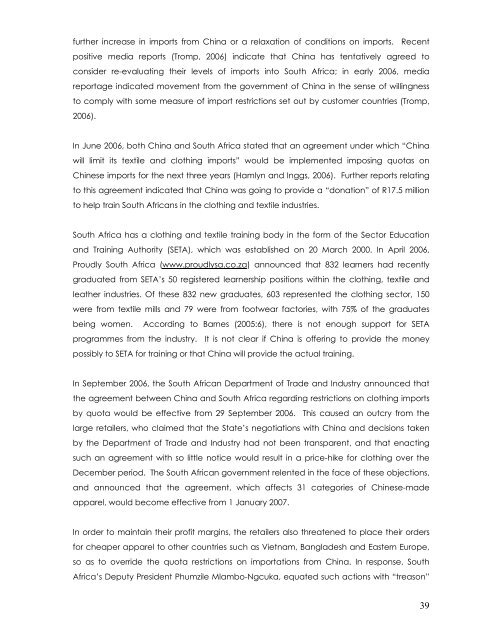Create successful ePaper yourself
Turn your PDF publications into a flip-book with our unique Google optimized e-Paper software.
further increase in imports from China or a relaxation of conditions on imports. Recent<br />
positive media <strong>report</strong>s (Tromp, 2006) indicate that China has tentatively agreed to<br />
consider re-evaluating their levels of imports into South Africa; in early 2006, media<br />
<strong>report</strong>age indicated movement from the government of China in the sense of willingness<br />
to comply with some measure of import restrictions set out by customer countries (Tromp,<br />
2006).<br />
In June 2006, both China and South Africa stated that an agreement under which “China<br />
will limit its textile and clothing imports” would be implemented imposing quotas on<br />
Chinese imports for the next three years (Hamlyn and Inggs, 2006). Further <strong>report</strong>s relating<br />
to this agreement indicated that China was going to provide a “donation” of R17.5 million<br />
to help train South Africans in the clothing and textile industries.<br />
South Africa has a clothing and textile training body in the form of the Sector Education<br />
and Training Authority (SETA), which was established on 20 March 2000. In April 2006,<br />
Proudly South Africa (www.proudlysa.co.za) announced that 832 learners had recently<br />
graduated from SETA’s 50 registered learnership positions within the clothing, textile and<br />
leather industries. Of these 832 new graduates, 603 represented the clothing sector, 150<br />
were from textile mills and 79 were from footwear factories, with 75% of the graduates<br />
being women. According to Barnes (2005:6), there is not enough support for SETA<br />
programmes from the industry. It is not clear if China is offering to provide the money<br />
possibly to SETA for training or that China will provide the actual training.<br />
In September 2006, the South African Department of Trade and Industry announced that<br />
the agreement between China and South Africa regarding restrictions on clothing imports<br />
by quota would be effective from 29 September 2006. This caused an outcry from the<br />
large retailers, who claimed that the State’s negotiations with China and decisions taken<br />
by the Department of Trade and Industry had not been transparent, and that enacting<br />
such an agreement with so little notice would result in a price-hike for clothing over the<br />
December period. The South African government relented in the face of these objections,<br />
and announced that the agreement, which affects 31 categories of Chinese-made<br />
apparel, would become effective from 1 January 2007.<br />
In order to maintain their profit margins, the retailers also threatened to place their orders<br />
for cheaper apparel to other countries such as Vietnam, Bangladesh and Eastern Europe,<br />
so as to override the quota restrictions on importations from China. In response, South<br />
Africa’s Deputy President Phumzile Mlambo-Ngcuka, equated such actions with “treason”<br />
39
















